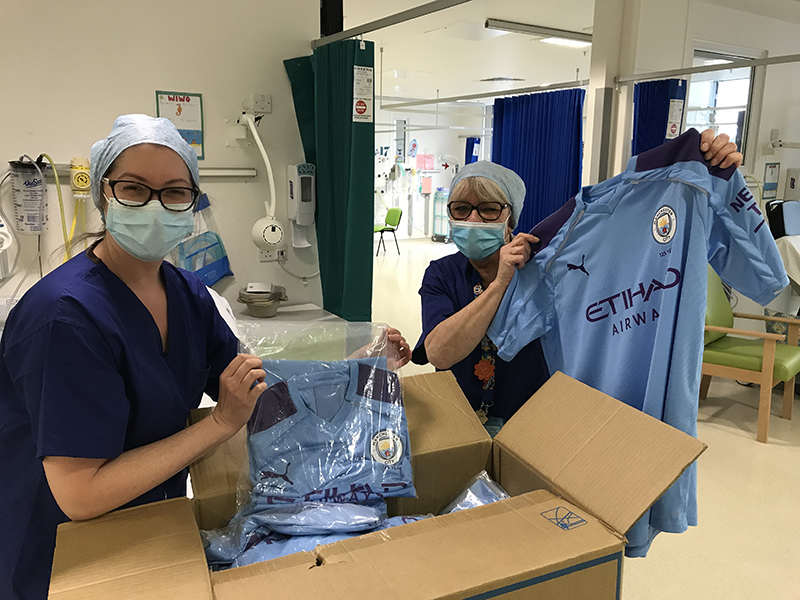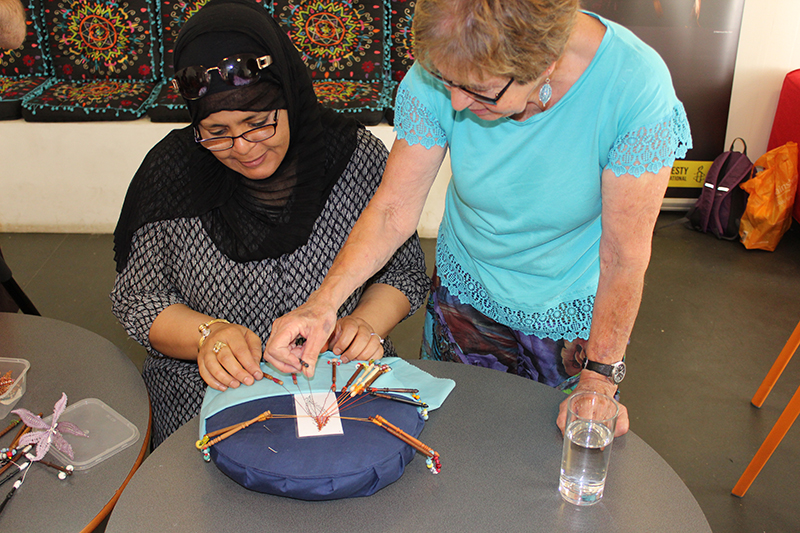Style and sustainability
With the world waking up to the devastating impact of man-made climate change, every major industry has a part to play in achieving a more sustainable future.
And as one of the most damaging polluters in the world, the fashion industry is no exception. According to the United Nations, it’s responsible for an estimated 8-10% of global carbon emissions through the production, manufacturing and transportation of garments.
Sustainability has taken centre stage in the industry in recent years and is now one of the biggest concerns for fashion brands. It’s not just how an item of clothing looks anymore, but where it came from, and how it was made.
During COP26, the United Nations climate change conference held last year, many fashion brands made commitments to reduce their carbon footprint.
Shoppers have also become more aware of the damaging environmental impact of fashion, particularly around the issues with fast fashion and the mass production of cheap, disposable clothes that are only worn a handful of times.
Manchester Fashion Institute at Manchester Met is helping to make positive changes in the industry, recently signing up to the United Nations Economic Commission for Europe (UNECE) Sustainability Pledge, a call to action for garment and footwear sectors to improve transparency and traceability in supply chains by implementing the UNECE Textiles Transparency Toolbox.
This follows on from the Fashion Institute joining the Textiles 2030 sustainability initiative that aims to transform the way the UK supplies, uses and disposes of clothing and textiles over the next ten years.
Fashion Institute research is also helping the fight back against clothing waste, influencing consumer behaviour, and promoting innovative textiles solutions to social problems.
Met Magazine heard from five projects that are working hard to make positive changes within the industry.
Innovative upcycling
Whether it doesn’t fit, has gone out of fashion, or simply still has the price tags on – we’re all guilty of keeping unwanted clothes hidden at the back of our wardrobes.
The growing popularity of upcycling – the repurposing of existing clothing – can give unwanted clothing a new lease of life while also having a positive impact on the environment and society.
Fashion Institute researchers have developed a new pilot project in collaboration with Royal Manchester Children’s Hospital and Her Majesty’s Prison and Probation Service (HMPPS) to design and create new hospital gowns using football shirts donated by Manchester City Football Club, which sponsored the research project.

Designed by staff and students, the innovative hospital gowns were donated to Royal Manchester Children’s Hospital with the aim of helping, supporting, and improving the experience for children who are undergoing surgery.
Students, academics and technical staff from the Fashion Institute and the Departments of Nursing and Psychology worked alongside hospital staff and the families of some of the hospital’s young patients to research, develop and deliver the new designs.
Prototype gown samples were developed and tested with the textile teams at HMPPS, who manufactured the gowns.
The team also produced a report, examining the effectiveness of the technical design of the gown and how it helps young hospital patients, with recommendations for wider use.

Barbara Shepherd, Principal Lecturer and Knowledge Exchange Lead, who worked on the project explained: “This project has far reaching potential. We have piloted this redesign with one local football club – this could apply to other football clubs both nationally and internationally. With local prison-based manufacturing support, this proposal offers an affordable sustainable solution for football clubs to support the sustainability agenda.”
Changing consumer behaviour
We’ve all heard about the negative impact of fast fashion on the environment. Campaigning has ramped up to hold fashion brands to account, but change has been slow.
According to findings from Citizens’ Assemblies (government focus groups), consumers are now ready to embrace change.
Research by Fiona Hackney, Professor of Fashion at Manchester Fashion Institute, has explored how consumers can develop pro-environmental behaviour.

The study, funded by the Arts and Humanities Research Council, proposed that change comes through processes of consensus and co-operation, which are best achieved through collective acts of creativity: making, caring, sharing, repurposing, and repairing existing garments.
In workshops designed to encourage behaviour change, participants gained hands-on experience of working with natural yarns and dyes, hand-spinning and weaving, learning repairing skills, bespoke pattern cutting, and how to repurpose garments.
Prof Hackney said: “Participants said that working hands-on to learn skills and repurpose garments gave them the courage and inspiration to tackle repairs and modifications and to shop more sustainably rather than buying the latest fashion.”
Clothing diaries and wardrobe audits, including clothing counts and interviews, helped participants to understand their shopping habits, and tell their ‘clothing stories’ detailing how and when they bought garments, why they kept them, and how often they’re worn.
Findings revealed three drivers for successful behavioural change: connection with a like-minded community to reinforce behaviour, affectual engagement with the materiality of garments (their unique qualities) to realise change, and personal investment.
Prof Hackney said: “What became clear was the importance of memory in participants’ relationship with clothing. This influenced a set of personalised strategies to increase the longevity of clothing and reduce environmental impact.”
A new set of priorities emerged – to care for clothes, respect and value them, and pay attention to how garments could connect us to others.

The research was featured in the 2019 Environmental Audit Committee Report and recommended that making, repair and repurposing hubs are established in shops, galleries, schools, and community spaces.
A collaboration between designers, small businesses, and communities, these hubs would embrace slow fashion, normalise these activities, and help regenerate the high street.
Prof Hackney said: “Sustainable behaviour is not about giving things up, but about making the most of what we have, connecting with others, and making new and more caring versions of ourselves.”
Plant-based antimicrobial textiles
The COVID-19 pandemic has changed our approach to personal health and hygiene.
As a result, the textile industry is now embracing the use of antimicrobial textiles to help fight disease.
Research by Dr Prabhuraj Venkatraman, Senior Lecturer in Textile Technology at the Fashion Institute has revealed a new method for using plant-based herbal nano-emulsions in an innovative way which could prevent the spread of disease.
An eco-friendly, plant-based dry wipe that could be used on the hands and face for personal hygiene has been developed and could tackle infection.
Researchers have created an environmentally friendly finishing method for textiles with antimicrobial properties, which can be applied to organic cotton fabrics that can be washed and used repeatedly.
The study funded by the Global Challenges Research Fund and carried out by the Fashion Institute and the Department of Fibres and Textile Processing Technology at Institute of Chemical Technology (ICT), Mumbai, suggests the antimicrobial finishing method could be scaled up to help improve hygiene and health at a community level using locally produced herbs from India.
It is hoped the wipes could provide an easily accessible hygienic cleaning option where access to water is limited.

Dr Venkatraman said: “These dry wipes could provide people all over the world with access to hygienic cleaning products where they might otherwise have limited options with clean water being scarce.”
Researchers focussed on using plant-based substances, which are widely available and known to possess natural antimicrobial properties, offering an environmentally friendly approach.
Dr Venkatraman added: “The natural, plant-based coating means they are environmentally friendly and using locally sourced materials provides a sustainable product that can be used repeatedly.
This new finishing method could be beneficial when applied to antimicrobial textile products for personal hygiene which could include reusable pocket tissues or handkerchiefs for the hands and face.
Based on these findings, researchers are in discussion with industry to expand on the research and determine a way to implement this method on a larger scale.
Zero-waste framework for sustainable mass production
Fast fashion offers convenient, easy access to low-cost clothing. But it is also one of the main culprits of waste during the production process.
So, what can be done to reduce textile waste when producing garments on such a large scale?
A Global Challenges Research Fund (GCRF) 20/21 project, led by principal investigator Dr. Abu Sadat Muhammad Sayem from the Fashion Institute, investigated ways of implementing a zero-waste pattern cutting (ZWPC) approach in the mass production of fast fashion.

The project team developed a new framework for sustainable fashion and textile production in consultation with stakeholders which was introduced to apparel professionals and manufacturers in Bangladesh in collaboration with Bangladesh University of Textiles (BUTEX) and BGMEA University of Fashion & Technology (BUFT).
Featuring guidelines for near zero-waste, the framework could be implemented more widely by fashion and textile brands.
“Our framework focuses on three key actions – identify, act, and evaluate, to achieve complete environmental sustainability in fashion and textile production,” Dr. Muhammad Sayem said.
“It emphasises zero or near-zero waste generation at source and incorporates sustainability thinking in material and process selections, rather than postproduction waste management.”
The framework was presented during a roundtable discussion last year to international fashion retailers including Decathlon, Next and M&S, and organisations including United Nations Industrial Development Organisation and International Labour Organisation.
This project followed previous research by Dr Muhammad Sayem demonstrating the successful application of ZWPC in mass production of clothing, addressing the issue of fabric waste production from the global fashion industry, which amounts to over 60 billion square metres annually.
The ZWPC was implemented for multiple sizes of clothing simulating a mass production scenario which could achieve over 98% of fabric utilisation in clothing production.
Circular textiles
The fashion industry produces an estimated 92 million tonnes of waste per year, according to the Ellen MacArthur Foundation.
By 2030, this is expected to rise to more than 134 million tonnes.
Manchester Met was one of 20 partners in RESYNTEX, an EU circular economy initiative to transform discarded textile waste into a valuable resource that could be used in the textile and chemical industries, reducing overall waste ending up in landfill.
Using innovative technologies, researchers created a new synergy between the textiles and chemical industries which involved collaboration across the whole textile value chain.
The project, funded by the EU Horizon 2020 programme, addressed the challenges faced when implementing a new circular economy within the textile sector utilising pioneering technologies in the chemical repossessing of clothing waste.
Involving stakeholders in the research process was crucial to identifying the most relevant opportunities and barriers for each textile waste stream to be diverted from landfill.
The project concluded with the construction of a pilot textile recycling plant in Slovenia with the capability to process 100 tonnes of textile waste per year.
Chemical processes were researched and refined in the lab to treat textile waste, before being scaled up to deliver the pilot plant.
After decolourisation, textile fibres are converted, forming the foundation for commercially valuable products like wood adhesives, bioethanol, and resin.
This new circular economy model could be adapted to new markets and could help consumers to understand the recycling value of clothing and the impact on the environment.
Research is ongoing to refine and improve processes and the team hopes to launch a follow-up project to achieve commercial viability.
